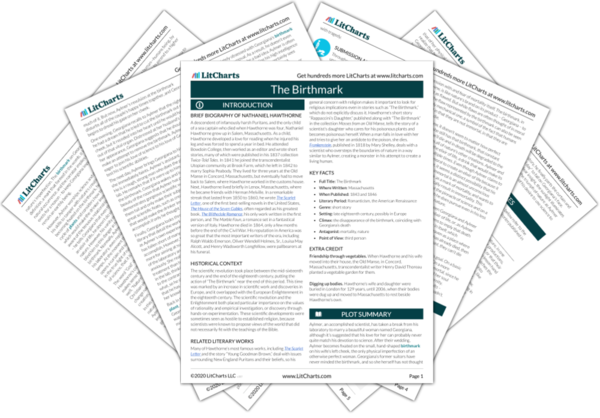Welcome to the LitCharts study guide on Nathaniel Hawthorne's The Birthmark. Created by the original team behind SparkNotes, LitCharts are the world's best literature guides.
The Birthmark: Introduction
A concise biography of Nathaniel Hawthorne plus historical and literary context for The Birthmark.
The Birthmark: Plot Summary
A quick-reference summary: The Birthmark on a single page.
The Birthmark: Detailed Summary & Analysis
In-depth summary and analysis of every of The Birthmark. Visual theme-tracking, too.
The Birthmark: Themes
Explanations, analysis, and visualizations of The Birthmark's themes.
The Birthmark: Quotes
The Birthmark's important quotes, sortable by theme, character, or .
The Birthmark: Characters
Description, analysis, and timelines for The Birthmark's characters.
The Birthmark: Symbols
Explanations of The Birthmark's symbols, and tracking of where they appear.
The Birthmark: Literary Devices
The Birthmark's key literary devices explained and sortable by chapter.
The Birthmark: Theme Wheel
An interactive data visualization of The Birthmark's plot and themes.
Brief Biography of Nathaniel Hawthorne
A descendent of infamously harsh Puritans, and the only child of a sea captain who died when Hawthorne was four, Nathaniel Hawthorne grew up in Salem, Massachusetts. As a child, Hawthorne developed a love for reading when he injured his leg and was forced to spend a year in bed. He attended Bowdoin College, then worked as an editor and wrote short stories, many of which were published in his 1837 collection Twice-Told Tales. In 1841 he joined the transcendentalist Utopian community at Brook Farm, which he left in 1842 to marry Sophia Peabody. They lived for three years at the Old Manse in Concord, Massachusetts, but eventually had to move back to Salem, where Hawthorne worked in the customs house. Next, Hawthorne lived briefly in Lenox, Massachusetts, where he became friends with Herman Melville. In a remarkable streak that lasted from 1850 to 1860, he wrote The Scarlet Letter, one of the first best-selling novels in the United States, The House of the Seven Gables, often regarded as his greatest book, The Blithedale Romance, his only work written in the first person, and The Marble Faun, a romance set in a fantastical version of Italy. Hawthorne died in 1864, only a few months before the end of the Civil War. His reputation in America was so great that the most important writers of the era, including Ralph Waldo Emerson, Oliver Wendell Holmes, Sr., Louisa May Alcott, and Henry Wadsworth Longfellow, were pallbearers at his funeral.
Get the entire The Birthmark LitChart as a printable PDF.

Historical Context of The Birthmark
The scientific revolution took place between the mid-sixteenth century and the end of the eighteenth century, putting the action of “The Birthmark” near the end of this period. This time was marked by an increase in scientific work and discoveries in Europe, and it overlapped with the European Enlightenment in the eighteenth century. The scientific revolution and the Enlightenment both placed particular importance on the values of rationality and empirical investigation, or discovery through hands-on experimentation. These scientific developments were sometimes seen as hostile to established religion, because scientists were known to propose views of the world that did not necessarily fit with the teachings of the Bible.
Other Books Related to The Birthmark
Many of Hawthorne’s most famous works, including The Scarlet Letter and the story “Young Goodman Brown,” deal with issues surrounding New England Puritans and their beliefs, so his general concern with religion makes it important to look for religious implications even in stories such as “The Birthmark,” which do not explicitly discuss it. Hawthorne’s short story “Rappaccini’s Daughter,” published along with “The Birthmark” in the collection Mosses from an Old Manse, tells the story of a scientist’s daughter who cares for his poisonous plants and becomes poisonous herself. When a man falls in love with her and tries to give her an antidote to the poison, she dies. Frankenstein, published in 1818 by Mary Shelley, deals with a scientist who oversteps the boundaries of nature in a way similar to Aylmer, creating a monster in his attempt to create a living human.
Key Facts about The Birthmark
- Full Title: The Birthmark
- Where Written: Massachusetts
- When Published: 1843 and 1846
- Literary Period: Romanticism, the American Renaissance
- Genre: short story
- Setting: late eighteenth century, possibly in Europe
- Climax: the disappearance of the birthmark, coinciding with Georgiana’s death
- Antagonist: mortality, nature
- Point of View: third person
Extra Credit for The Birthmark
Friendship through vegetables. When Hawthorne and his wife moved into their house, the Old Manse, in Concord, Massachusetts, transcendentalist writer Henry David Thoreau planted a vegetable garden for them.
Digging up bodies. Hawthorne’s wife and daughter were buried in London for 129 years, until 2006, when their bodies were dug up and moved to Massachusetts to rest beside Hawthorne’s own.












